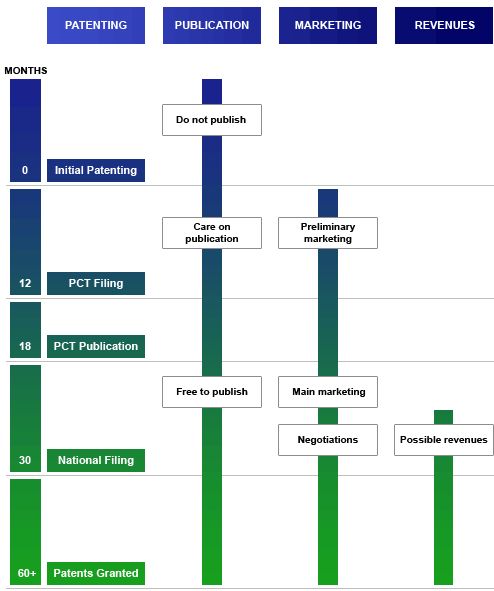PBL Guide to Patenting
Legal Advice: None of the information provided herein by PBL is intended to provide a legal opinion. PBL encourages inventors and applicants to seek legal advice from qualified lawyers and intellectual property professionals. We are happy to help in this process.
About Patents
A granted patent generally gives the patent owner the right to stop others from making, using, selling, licensing, etc. the patented invention, as defined in the “claims”. A patent is a social contract between the government and the individual owner(s) which grants a patent in return for a complete description of the invention. The purpose of this social contract is to encourage the dissemination of new information so that others may learn from and improve on them (as opposed to keeping new knowledge secret). The patent owner can then benefit from a limited monopoly as defined in the claims of the granted patent.
Terminology
A patent needs to be officially “granted “or “issued” by a state Patent Office. Before being granted, it is a patent “application” that is reviewed by a patent examiner and at this time it is sometimes described as “pending”. Submitting a patent application to a Patent Office is termed “filing” a patent application. The terms “application” and “filing” are synonymous and both can be used as a verb (the action of submitting the application) or as a noun (the document itself can be described the “application” or the “filing”), often in the same sentence and interchangeably, which may seem confusing!
Structure of a Patent Application
A patent (or patent application) is a formal document (often referred to as the “specification”) containing:
- The background to the invention – describing the existing problem, current practices and challenges
- The description of the invention
- Examples of the invention and its uses
- Figures and tables and other attached data (e.g., DNA or amino acid sequence)
The specification also includes details of the inventors, the patent applicant, and a set of “claims”. The claims are a precisely constructed set phrases and sentences that describe the scope of the invention in all its possible aspects. During the examination process (see below), the official patent examiner will decide if the claims are allowable based on the support for them in the specification. During this process the applicant may be invited to modify the claims so as to come into line with what the examiner is willing to allow.
The Patent Process
Preparing and Prosecuting Patent Applications
Patents are both legal and technical documents that describe an invention. The best patents describe the invention as fully as possible and in such a way as to provide the reader with sufficient information to be able to replicate the invention as this is part of the social contract described above. The invention itself may be a material thing (e.g., a machine, or a gene, or, depending on the country, even certain living organisms), a process for making something or doing something useful, etc.
Patents and the Patent Law are constantly evolving as do the requirements for a patent. Writing a patent application is a specialised task and should be conducted by a patent professional.
A patent application is typically not an enforceable right until it has been granted by a Patent Office. Once drafted, a patent application is filed in a Patent Office to assess whether it complies with that jurisdiction’s laws.
During the examination process (often described as “patent prosecution”), the patent examiner will review the patent application to decide if the claims are allowable based on the details in the specification and the jurisdiction’s patent law. If the patent examiner is satisfied, then they will recommend to the Patent Office to allow the application to become a granted patent. During this review process the applicant may be invited to modify the claims to satisfy the patent examiner. This process may take many years and may be very costly. This should be factored into the decision whether or not to file a patent application in the first place. Typically, a granted patent provides limited rights for 20-21 years from the initial application date.
Defending and Enforcing a Granted Patent
Any member of the public may attempt to revoke a granted patent by challenging its validity. Alternatively, third parties may knowingly or unknowingly infringe the claims of the granted patent. In either case a patent owner should be able and prepared to defend the patent in the event of revocation proceedings, or to enforce the patent against infringers. Enforcement may be conducted via the courts, or sometimes administrative agencies.
Patentability
Basic criteria for a patentable invention are contained in each jurisdiction’s patent law and typically include: (i) Novel (new) (ii) Non-obvious/inventive (surprising), (iii) be industrially applicable (useful), and (iv) allowed by the law/not prohibited from patenting.
An idea, a discovery, or an observation may not be patentable by itself (e.g. a new explanation of what is happening in steps of a molecular pathway) may not necessarily qualify as an invention. Although an invention may be based on a discovery, the discovery itself may not be patentable. Patent Offices typically exclude mere ideas, discoveries and various other items from patentability. However, a discovery may lead to a patentable invention if the discovery is accompanied by a description of how the discovery is used to form an invention that is industrially applicable.
Therefore, the patent application should clearly explain how the idea / discovery forms the basis of the invention. This is usually described in specific, detailed examples contained in the patent application showing that the idea / discovery has a technical basis rather than a merely theoretical basis.
i) Novelty
Inventions must be new/novel. If an invention has been already disclosed or made publicly available in any shape or form or disclosed without any confidentiality obligation before a patent is filed, then it is no longer novel. Disclosure is not limited to scientific publications and may be in any form (oral, written, digital, etc.).
Disclosures may include:
- a published paper or written article
- an abstract for a conference paper/poster sent to a conference organiser
- a thesis in a university library
- available on the internet (e.g., a website)
- poster sessions at conferences
- an oral presentation (including slides) at a conference/seminar
- emails
- informal conversation
- providing a sample to someone
- exhibiting material on e.g., a stand at a conference or trade show
- providing a sample to a collaborator in circumstances where confidentiality arrangements do not operate explicitly or are not implied.
ii) Non-obvious (= inventive)
Inventions typically require an inventive step (i.e., be "non-obvious") meaning that the patent must describe an invention that is surprising or not expected to those who know that technology. This is usually the most contentious issue in determining patentability. The tests to determine whether an invention is inventive are formulated differently by the Patent Offices in different jurisdictions. Therefore, the objections raised during examination of the patent application will differ in different countries, depending on the prior art cited, the starting position identified for assessing inventive step and the criteria for inventive step test in that jurisdiction.
iii) Industrial applicability
In most jurisdictions, an invention typically must solve an existing technical problem and must be useful in an industrial setting, meaning it should be producible and useable.
This applicability must be described in the patent application with examples that are clear and accurate, and more than mere speculation.
iv) Allowed by law/not prohibited
Jurisdictions vary as to what may or may not be patented based on legal, moral, ethical and other factors. The patent law on such matters is often changing and developing, as new technologies open new possibilities.
Still have questions?
If you have any questions about what is considered a disclosure, or about local patent requirements such as novelty, inventive step, industrial applicability etc., then PBL suggests obtaining advice from a qualified attorney or a patent professional, and we will help you to do so. Please contact us.
Patenting and Commercialisation Process
Please click here for a printable PDF

